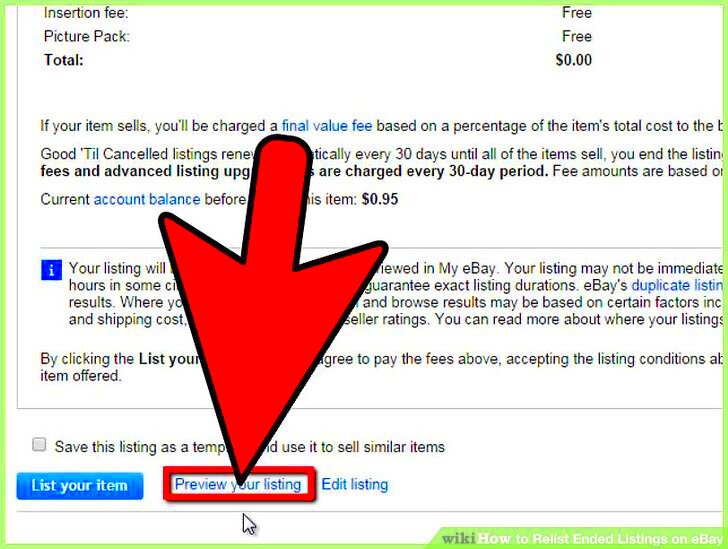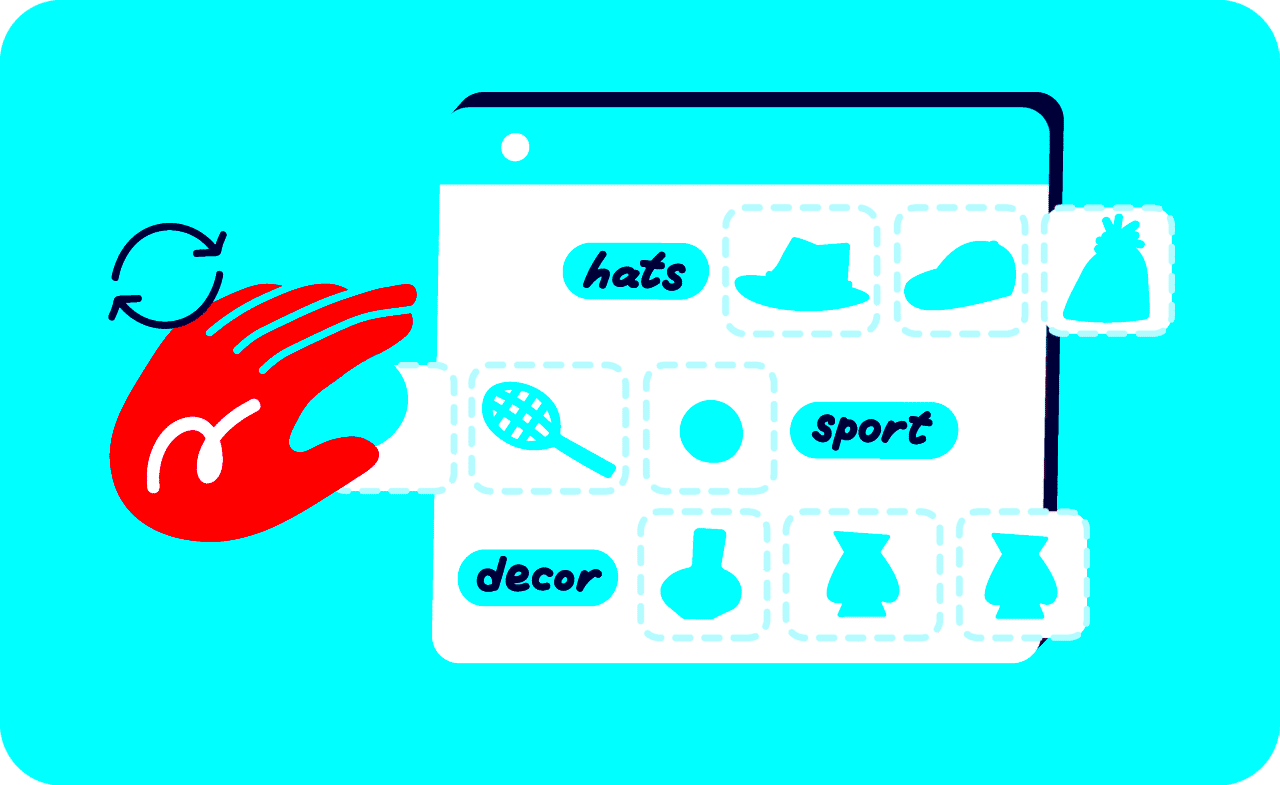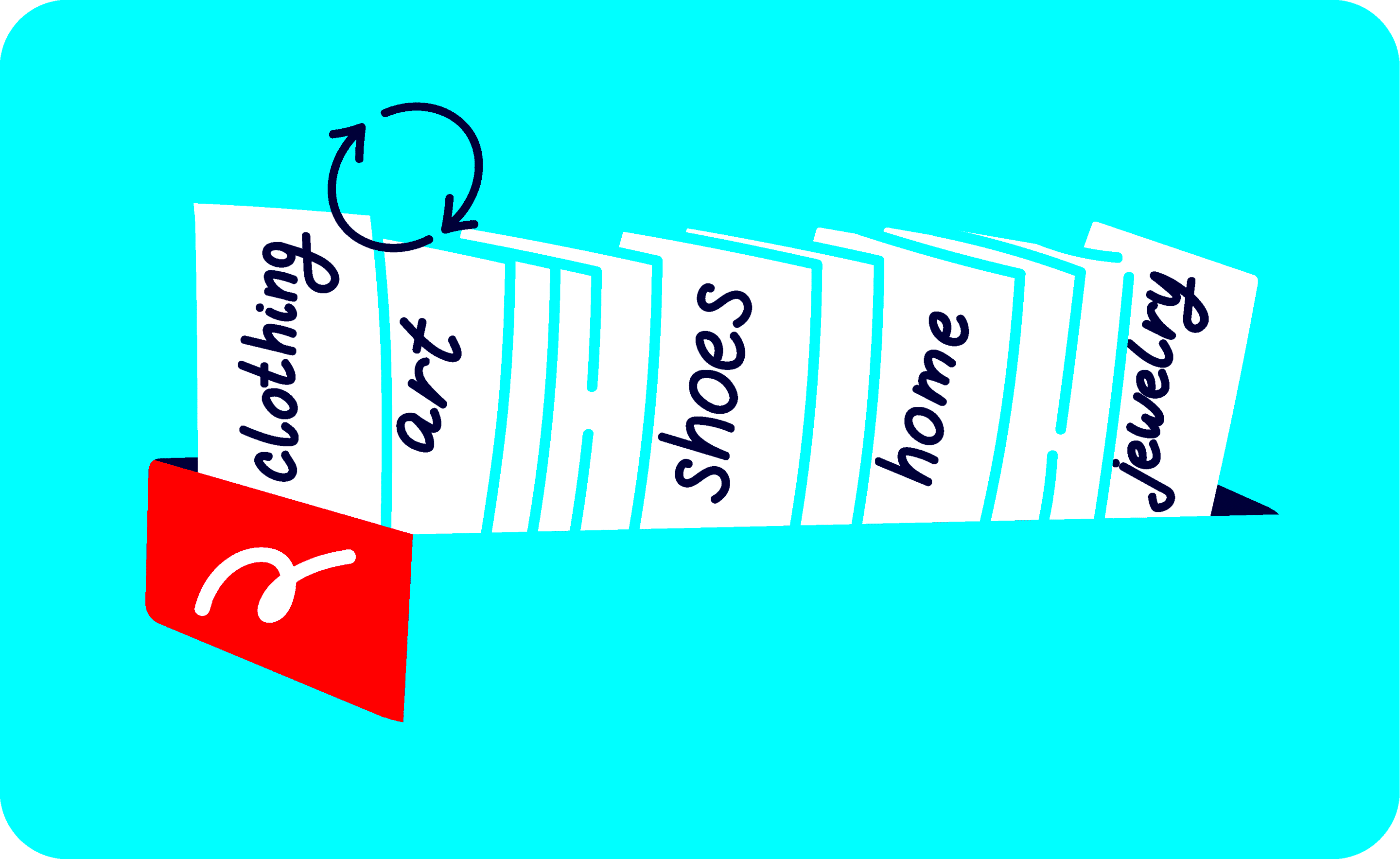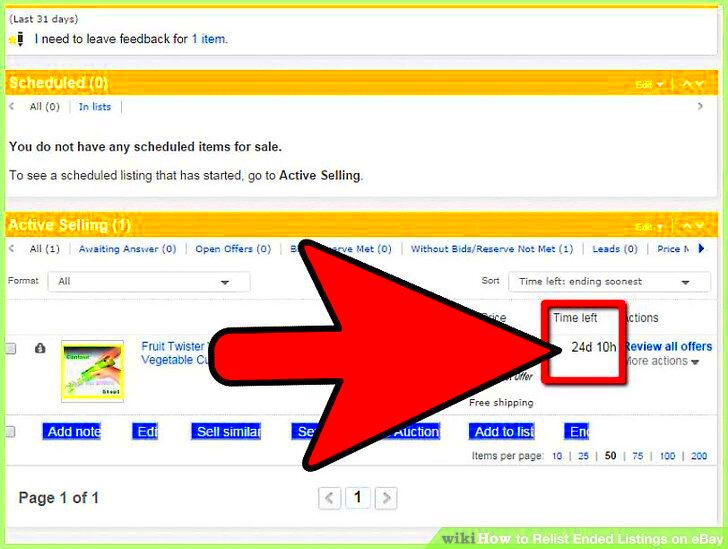Have you ever caught yourself looking at a product on
eBay and pondering whether it's worth trying to sell again? Giving it another listing can really make a difference. It's not merely about refreshing the page; it's about revitalizing your item and grabbing the attention of potential new buyers. I can still recall my encounter with relisting. With some adjustments and a different strategy that persistent item eventually found a buyer. At times a dash of determination yields great rewards!
Understanding the Relisting Process: What You Need to Know

Before getting into the process of relisting an item it’s important to understand the advantages it brings. Relisting involves making a new listing for a product that didn’t sell previously. This gives your product another chance to be seen by potential buyers who may have overlooked it before.Here’s what you need to know:
- Timing is Key: Relisting too soon might not give your item a fair chance. Ideally, wait until the initial listing’s visibility has faded.
- Review Your Original Listing: Look at what went wrong. Did your title and description lack appeal? Was the price too high?
- Update Details: Use the insights you’ve gained to make improvements. This might include better photos, a more compelling description, or a more competitive price.
Relisting goes beyond simply showing up again on the market. Its about gaining insights and making adjustments to achieve improved outcomes.
Steps to Relist an Item: A Simple Guide

Reposting something on
eBay doesn't have to be a hassle. By following a few simple steps you can bring your item back into the limelight. Here's a guide to assist you in the process.
- Log into Your eBay Account: Go to the "My eBay" section and find your unsold item under the "Sold" or "Unsold" listings.
- Select the Item: Click on the item you want to relist. You’ll see an option to “Relist” or “Sell Similar.”
- Revise Your Listing: Update the title, description, and photos. Make sure to highlight any new features or changes.
- Set a Competitive Price: Review similar listings to set a price that’s attractive to buyers.
- Choose the Right Listing Duration: Decide if you want a 7-day or 30-day listing. Longer durations can sometimes help with visibility.
- Preview and Publish: Double-check everything before you hit the “List Item” button. Once satisfied, publish your relisted item.
Reposting can be a great chance to fine tune your strategy and aim for improved outcomes this time. So, take a moment to gather yourself and put in your utmost effort!
Tips for Crafting a Better Listing: Making Your Item Stand Out

Creating an
eBay listing is like opening a cozy store in a crowded marketplace. You want your product to grab attention and make potential buyers pause for a closer look. I remember when I tried selling my grandmothers antique jewelry. I initially thought the vintage photos would do the trick but then I gave the listing a makeover. Fresh images, a more detailed description and a touch of storytelling really boosted my success. Here are some tips to help your item shine, in the spotlight:
- Use High-Quality Photos: Your photos should be clear, well-lit, and show the item from multiple angles. A cluttered background can detract from the focus. Remember, a picture is worth a thousand words!
- Write a Detailed Description: Be specific about the item’s condition, size, and features. If it has a unique history or an interesting backstory, share that too. The more details, the more informed your buyers will be.
- Choose an Engaging Title: Use keywords that buyers might search for. Instead of “Vintage Necklace,” try “Handmade 1950s Gold Plated Vintage Necklace – Elegant & Unique.”
- Highlight Benefits: Explain how your item solves a problem or adds value. If it’s a gadget, detail how it improves the buyer’s life.
Enhancing the visual and informative aspects of your listing increases the likelihood of your item standing out against competitors.
Common Mistakes to Avoid When Relisting

Even with good intentions relisting something can go wrong if you’re not cautious. I’ve discovered this through my own trials and mistakes. Here’s a summary of pitfalls to steer clear of drawn from my personal encounters.
- Ignoring Previous Feedback: If your initial listing didn’t sell, there might be clues in buyer feedback or views. Avoid repeating the same mistakes.
- Overlooking Price Adjustments: If your item didn’t sell before, check if the price was a barrier. A small adjustment could make a big difference.
- Skipping Updates: Don’t simply relist the same content. Refresh your title, description, and photos to reflect any changes or improvements.
- Neglecting the Competition: See how similar items are listed. Position your item competitively in terms of price, description, and presentation.
Steering clear of these typical missteps can boost the effectiveness of your relisting and improve your odds of making a successful sale.
How to Use eBay’s Relisting Tools Effectively
eBay offers a range of features to simplify the process but many users tend to overlook them. Personally I found these tools to be extremely helpful when dealing with a bunch of items that didn’t sell. Here’s a guide on how to maximize their effectiveness.
- Use the “Sell Similar” Feature: Instead of just relisting, use this feature to create a new listing with the same details but freshened up. This is particularly useful for adjusting descriptions and photos based on what you’ve learned.
- Analyze Seller Reports: eBay’s seller reports offer insights into how your listings are performing. Use these insights to adjust your strategy, like tweaking the timing of your listings.
- Set Up Automated Relisting: For high-volume sellers, eBay’s automated relisting can save time. You can configure it to relist items that didn’t sell, without manual intervention.
- Utilize Promotional Tools: eBay offers promotional tools to boost visibility. Consider using promotions, discounts, or featured listings to get more eyes on your items.
Using these tools can make it easier to relist items and possibly boost your sales results. The key is to be more efficient in your approach rather than putting in more effort.
Monitoring Your Relisted Item: Tracking Performance and Making Adjustments
Once you’ve put your item back up for sale what comes next? Just like I tend to my garden after sowing seeds keeping an eye on your relisted item is essential. There was a time when I believed that relisting was a matter of setting it and forgetting it. However I discovered that staying involved can make a significant impact. Here’s how you can monitor your items performance and make adjustments as necessary.
- Check Your eBay Analytics: eBay provides tools to track views, watchers, and offers. Regularly reviewing these metrics can give you insights into how your item is performing.
- Analyze Buyer Behavior: If your item is getting views but no bids or purchases, it might be time to adjust your listing. Check if the title or description needs refinement.
- Adjust Pricing If Needed: If your item isn’t attracting buyers, consider tweaking the price. Sometimes a small adjustment can make a significant impact.
- Respond to Questions Promptly: Engage with potential buyers who ask questions. Quick responses can build trust and potentially lead to a sale.
By keeping a close eye on things and making changes using information you increase the likelihood of your product thriving. It’s similar to nurturing a plant—consistent care and focus can result in a rewarding harvest.
Additional Resources and Tools for eBay Sellers
Selling on
eBay can be like trying to find your way through an ocean without any guidance. Throughout the years I’ve come across different resources and tools that have really come in handy. Whether you’re an experienced seller or just getting started these tools can really help you out.
- eBay Seller Hub: This is your control center. It provides sales data, performance metrics, and insights into how your listings are performing.
- eBay Community Forums: Connect with other sellers, share experiences, and get tips. I’ve learned a lot from these forums, especially about new trends and strategies.
- Third-Party Tools: Consider using tools like Terapeak for market research and research trends. Inventory management tools can also help keep track of your stock.
- eBay’s Seller Help Pages: These pages are filled with valuable information about policies, best practices, and troubleshooting tips. They’re a great resource if you’re ever stuck.
These tools can simplify your sales approach and offer useful perspectives that may result in improved sales performance and a more seamless selling journey.
FAQ: Answers to Common Questions About Relisting on eBay
If you have inquiries about relisting, you're in good company. Numerous sellers ponder the optimal methods and typical challenges associated with relisting products. Drawing from my own experiences and insights from other sellers, I've compiled a list of questions that are often asked,
Q: How often should I relist an item?
- A: There’s no one-size-fits-all answer. It depends on the item and market trends. Generally, if an item hasn’t sold within a few weeks, it might be worth relisting with updated details.
Q: Can I use the same description for relisted items?
- A: It’s better to revise the description. Reflect on what didn’t work previously and make necessary adjustments to improve clarity and appeal.
Q: Is it beneficial to lower the price when relisting?
- A: Sometimes. If your item hasn’t attracted interest, consider adjusting the price. Competitive pricing can be a strong motivator for buyers.
Q: How do I know if my relisted item is performing well?
- A: Monitor metrics such as views, watchers, and offers. If engagement is low, it may be time to revisit your listing strategy.
Grasping these factors related to relisting can assist you in making choices and enhance your likelihood of achieving a successful sale.
Conclusion: Maximizing Your eBay Sales Through Effective Relisting
Relisting on eBay is not just a routine task; it’s a chance to enhance your approach and engage with potential buyers in a way. I’ve discovered that when done with care relisting can inject new energy into items that initially seemed stagnant. It involves drawing lessons from past encounters making thoughtful changes and staying attentive to how your listings are performing.By implementing the tips and strategies we've covered—such as refreshing your photos fine tuning your descriptions or utilizing eBay's features—you maximize the opportunities for your items to thrive. So, approach relisting with an outlook and you may find that those persistent listings eventually convert into sales. Keep experimenting adapting and let your eBay journey be an enriching experience that fosters your growth as a seller.
 Before getting into the process of relisting an item it’s important to understand the advantages it brings. Relisting involves making a new listing for a product that didn’t sell previously. This gives your product another chance to be seen by potential buyers who may have overlooked it before.Here’s what you need to know:
Before getting into the process of relisting an item it’s important to understand the advantages it brings. Relisting involves making a new listing for a product that didn’t sell previously. This gives your product another chance to be seen by potential buyers who may have overlooked it before.Here’s what you need to know: Reposting something on eBay doesn't have to be a hassle. By following a few simple steps you can bring your item back into the limelight. Here's a guide to assist you in the process.
Reposting something on eBay doesn't have to be a hassle. By following a few simple steps you can bring your item back into the limelight. Here's a guide to assist you in the process. Creating an eBay listing is like opening a cozy store in a crowded marketplace. You want your product to grab attention and make potential buyers pause for a closer look. I remember when I tried selling my grandmothers antique jewelry. I initially thought the vintage photos would do the trick but then I gave the listing a makeover. Fresh images, a more detailed description and a touch of storytelling really boosted my success. Here are some tips to help your item shine, in the spotlight:
Creating an eBay listing is like opening a cozy store in a crowded marketplace. You want your product to grab attention and make potential buyers pause for a closer look. I remember when I tried selling my grandmothers antique jewelry. I initially thought the vintage photos would do the trick but then I gave the listing a makeover. Fresh images, a more detailed description and a touch of storytelling really boosted my success. Here are some tips to help your item shine, in the spotlight: Even with good intentions relisting something can go wrong if you’re not cautious. I’ve discovered this through my own trials and mistakes. Here’s a summary of pitfalls to steer clear of drawn from my personal encounters.
Even with good intentions relisting something can go wrong if you’re not cautious. I’ve discovered this through my own trials and mistakes. Here’s a summary of pitfalls to steer clear of drawn from my personal encounters.
 admin
admin








